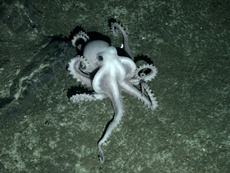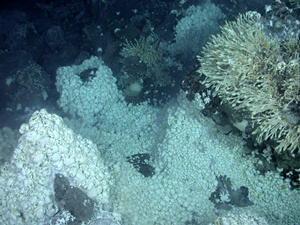‘Lost world’ discovered around Antarctic vents
04 Jan 2012
 The discoveries, made by teams led by the University of Oxford, University of Southampton, the National Oceanography Centre, and British Antarctic Survey, include new species of yeti crab, starfish, barnacles, and sea anemones, and even an octopus probably new to science.
The discoveries, made by teams led by the University of Oxford, University of Southampton, the National Oceanography Centre, and British Antarctic Survey, include new species of yeti crab, starfish, barnacles, and sea anemones, and even an octopus probably new to science.For the first time researchers, using a Remotely Operated Vehicle (ROV), have been able to explore the East Scotia Ridge deep beneath the Southern Ocean where hydrothermal vents, including 'black smokers' reaching temperatures of up to 382 degrees Celsius, create a unique environment lacking sunlight but rich in certain chemicals.
The team report their findings in this week's PLoS Biology.
"Hydrothermal vents are home to animals found nowhere else on the planet that get their energy not from the Sun but from breaking down chemicals, such as hydrogen sulphide," said Professor Alex Rogers of Oxford University's Department of Zoology, who led the research. "The first survey of these particular vents, in the Southern Ocean near Antarctica, has revealed a hot, dark, 'lost world' in which whole communities of previously unknown marine organisms thrive."
Highlights from the ROV dives include images showing huge colonies of the new species of yeti crab, thought to dominate the Antarctic vent ecosystem, clustered around vent chimneys. Elsewhere the ROV spotted numbers of an undescribed predatory seastar with seven arms crawling across fields of stalked barnacles and found an unidentified pale octopus nearly 2,400 metres down on the seafloor.
"What we didn't find is almost as surprising as what we did," said Professor Rogers. "Many animals such as tubeworms, vent mussels, vent crabs, and vent shrimps, found in hydrothermal vents in the Pacific, Atlantic, and Indian Oceans, simply weren't there."
 The team believe that the differences between the groups of animals found around the Antarctic vents and those found around vents elsewhere suggest that the Southern Ocean may act as a barrier to some vent animals. The unique species of the East Scotia Ridge also suggest that, globally, vent ecosystems may be much more diverse, and their interactions more complex, than previously thought.
The team believe that the differences between the groups of animals found around the Antarctic vents and those found around vents elsewhere suggest that the Southern Ocean may act as a barrier to some vent animals. The unique species of the East Scotia Ridge also suggest that, globally, vent ecosystems may be much more diverse, and their interactions more complex, than previously thought.In April, Professor Rogers was part of an international panel of marine scientists who gathered at Somerville College, Oxford to consider the latest research on the world's oceans. A preliminary report from the panel in June warned that the world's oceans are at risk of entering a phase of extinction of marine species unprecedented in human history.
"These findings are yet more evidence of the precious diversity to be found throughout the world's oceans," said Professor Rogers. "Everywhere we look, whether it is in the sunlit coral reefs of tropical waters or these Antarctic vents shrouded in eternal darkness, we find unique ecosystems that we need to understand and protect.













.jpg)






.jpg)









